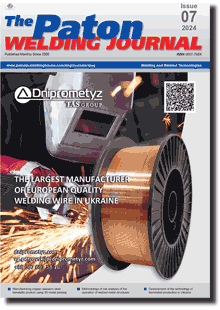Access for download PDF files for subscribers and for reviewers of scientometric bases.
Organization: Elsevier for content access(PDF files of journals released before 2024 are available for download from the website's archives))
Organization: Elsevier for content access(PDF files of journals released before 2024 are available for download from the website's archives))
| 2024 №07 (07) |
DOI of Article 10.37434/tpwj2024.07.01 |
2024 №07 (02) |

The Paton Welding Journal, 2024, #7, 3-9 pages
Manufacturing a consolidated copper-stainless steel bimetallic product using xBeam 3D metal printing
D. Kovalchuk1, L. Tretiakov1, P.R. Carriere2, Nanda Gopal Matavalam2
1JSC NVO Chervona Hvilya, 28 Dubrovytska str., 04200, Kyiv, Ukraine. E-mail: dmytro@xbeam3d.com2RadiaBeam Technologies, LLC, 1717 Stewart Str., Santa Monica, CA 90404, USA
Abstract
The creation of strong and tight copper and stainless steel joints in mechanical structures and components is an actual challenge in modern engineering. Thanks to unique combination of different properties such joints have many important applications like components of linear particle accelerators, ultra-high vacuum systems (up to 10–8 torr), heat exchangers, even of the international fusion experimental reactor. At the same time, ensuring a reliable joint of immiscible materials such as copper and stainless steel is a technologically challenging problem due to significantly different physical, mechanical and metallurgical properties, including melting points, thermal expansion coefficients, thermal conductivity, etc. Traditional approaches to the production of such joints, based on certain welding methods, impose many technical and geometric limitations due to the need for special preparation of the contact surfaces of the parts to be joined or the uncontrolled formation of new phases when mixing melts of different metals. As for brazing methods, they do not always provide reliable vacuum-tight joints for relatively thick parts and do not guarantee sufficient joint strength. Therefore, it is important to find more technologically flexible ways to solve such problems. This article discusses a new approach to joining copper and stainless steel using the xBeam 3D Metal Printing technology. This novel directed energy deposition (DED) technology uses a profile electron beam and coaxial feeding of copper wire to deposit it upon a precision machined stainless steel substrate. The results of the exploration study of joints made using this method are presented, including the study of vacuum tightness of the joint, density of the deposited material, metallurgy of the interface, electrical conductivity, oxygen content, hardness in different zones, etc. Specialized preheating strategies minimized the thermal deformation of the machined substrate, a key consideration for adding multimaterial functionality to monolith components.
Keywords: copper, stainless steel, joining, bimetals, additive manufacturing, metal 3D printing, electron beam, DED-wire
Received: 31.01.2024
Received in revised form: 12.04.2024
Accepted: 29.07.2024
References
1. Gaurang R. Joshi et al. (2022) The joining of copper to stainless steel by solid-state welding processes: A Review. Materials, 15(20), 7234. https://doi.org/10.3390/ma152072342. Raghavendra S. Darji et al. (2021) Exploiting the challenges of copper to austenitic stainless steel bimetallic joining by gas tungsten arc welding: A fluid flow perspective. In: Proc. of IOP Conf. on Materials Sci. and Eng., 1146, 012011. https://doi.org/10.1088/1757-899X/1146/1/012011
3. Gu, X., Cui, Z., Gu, X., Shao, J. (2021) Wire-feeding laserwelding of copper/stainless steel using different filler metals. Materials, 14(9), 2122. https://doi.org/10.3390/ma14092122
4. Turna, M., Sahul, M., Ondruska, J., Lokaj, J. (2011) Electron beam welding of copper to stainless steel. In: Proc. of Inter. DAAAM Symp., Vienna, Austria. Ed. by B. Katalinic. Vol. 22, 833-834. https://doi.org/10.2507/22nd.daaam.proceedings.409
5. Sahul, M., Sahul, M., Turˇna, M., Zacková, P. (2014) Disk laser welding of copper to stainless steel. Adv. Mater. Res., 1077, 76-81. https://doi.org/10.4028/www.scientific.net/AMR.1077.76
6. Osipovich, Kseniya S. et al. (2020) Gradient transition zone structure in "steel-copper" sample produced by double wirefeed electron beam additive manufacturing. J. of Materials Sci., 55, 9258-9272. DOI: https://doi.org/10.1007/s10853-020-04549-y 7. Rock, Christopher et al. (2021) Characterization of copper & stainless steel interface produced by electron beam powder bed fusion. Materials & Design, 212, 110278. DOI: https:// doi.org/10.1016/j.matdes.2021.110278
8. Kovalchuk, D.V., Melnik, V.I., Melnik, I.V., Tugaj, B.A. (2017) New possibilities of additive manufacturing using xBeam 3D Metal Printing technology (Review). The Paton Welding J., 12, 16-22. https://doi.org/10.15407/tpwj2017.12.03
9. Kovalchuk, D., Ivasishin, O. (2019) Profile electron beam 3D metal printing. In: Additive Manufacturing for the Aerospace Industry, 213-233. https://doi.org/10.1016/B978-0-12-814062-8.00012-1
10. Makhnenko, O.V., Milenin, A.S., Velikoivanenko, E.A. et al. (2017) Modelling of temperature fields and stress-strain state of small 3D sample in its layer-by-layer forming. The Paton Welding J., 3, 7-14. https://doi.org/10.15407/tpwj2017.03.02
Suggested Citation
D. Kovalchuk, L. Tretiakov, P.R. Carriere, Nanda Gopal Matavalam (2024) Manufacturing a consolidated copper-stainless steel bimetallic product using xBeam 3D metal printing. The Paton Welding J., 07, 3-9.The cost of subscription/purchase order journals or individual articles
| Journal/Currency | Annual Set | 1 issue printed |
1 issue |
one article |
| TPWJ/USD | 384 $ | 32 $ | 26 $ | 13 $ |
| TPWJ/EUR | 348 € | 29 € | 24 € | 12 € |
| TPWJ/UAH | 7200 UAH | 600 UAH | 600 UAH | 280 UAH |
| AS/UAH | 1800 UAH | 300 UAH | 300 UAH | 150 UAH |
| AS/USD | 192 $ | 32 $ | 26 $ | 13 $ |
| AS/EUR | 180 € | 30 € | 25 € | 12 € |
| SEM/UAH | 1200 UAH | 300 UAH | 300 UAH | 150 UAH |
| SEM/USD | 128 $ | 32 $ | 26 $ | 13 $ |
| SEM/EUR | 120 € | 30 € | 25 € | 12 € |
| TDNK/UAH | 1200 UAH | 300 UAH | 300 UAH | 150 UAH |
| TDNK/USD | 128 $ | 32 $ | 26 $ | 13 $ |
| TDNK/EUR | 120 € | 30 € | 25 € | 15 € |
AS = «Automatic Welding» - 6 issues per year;
TPWJ = «PATON WELDING JOURNAL» - 12 issues per year;
SEM = «Electrometallurgy Today» - 4 issues per year;
TDNK = «Technical Diagnostics and Non-Destructive Testing» - 4 issues per year.


